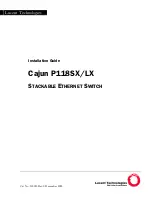
Chapter 67: LLDP and LLDP-MED
1050
Overview
Link Layer Discovery Protocol (LLDP) and Link Layer Discovery Protocol
for Media Endpoint Devices (LLDP-MED) allow Ethernet network devices,
such as switches and routers, to receive and transmit device-related
information to directly connected devices on the network that are also
using the protocols, and to store the information that is learned about other
devices. The data sent and received by LLDP and LLDP-MED are useful
for many reasons. The switch can discover other devices directly
connected to it. Neighboring devices can use LLDP to advertise some
parts of their Layer 2 configuration to each other, enabling some kinds of
misconfiguration to be more easily detected and corrected.
LLDP is a “one-hop” protocol; LLDP information can only be sent to and
received by devices that are directly connected to each other, or
connected via a hub or repeater. Devices that are directly connected to
each other are called neighbors. Advertised information is not forwarded
on to other devices on the network. LLDP is a one-way protocol. That is,
the information transmitted in LLDP advertisements flows in one direction
only, from one device to its neighbors, and the communication ends there.
Transmitted advertisements do not solicit responses, and received
advertisements do not solicit acknowledgements. LLDP cannot solicit any
information from other devices. LLDP operates over physical ports only.
For example, it can be configured on switch ports that belong to static port
trunks or LACP trunks, but not on the trunks themselves. In addition, LLDP
can be configured on switch ports that belong to VLANs, but not on the
VLANs themselves.
Each port can be configured to transmit local information, receive neighbor
information, or both. LLDP transmits information as packets called LLDP
Data Units (LLDPDUs). An LLDPDU consists of a set of Type-Length-
Value elements (TLV), each of which contains a particular type of
information about the device or port transmitting it.
A single LLDPDU contains multiple TLVs. TLVs are short information
elements that communicate complex data, such as variable length strings,
in a standardized format. Each TLV advertises a single type of
information, such as its device ID, type, or management addresses.
The TLVs are grouped as follows
“Mandatory LLDP TLVs” on page 1051
“Optional LLDP TLVs” on page 1051
“Optional LLDP-MED TLVs” on page 1053
Summary of Contents for AT-9000/12PoE
Page 4: ......
Page 28: ...Contents 28...
Page 36: ...Tables 36...
Page 42: ...42...
Page 76: ...Chapter 2 Starting a Management Session 76...
Page 100: ...Chapter 4 Basic Command Line Management Commands 100...
Page 112: ...112...
Page 130: ...Chapter 7 Basic Switch Management 130...
Page 170: ...Chapter 8 Basic Switch Management Commands 170...
Page 284: ...Chapter 12 Power Over Ethernet Commands 284...
Page 298: ...Chapter 13 IPv4 and IPv6 Management Addresses 298...
Page 322: ...Chapter 14 IPv4 and IPv6 Management Address Commands 322...
Page 342: ...Chapter 16 SNTP Client Commands 342...
Page 371: ...AT 9000 Switch Command Line User s Guide 371 awplus write Save the configuration...
Page 388: ...Chapter 19 Enhanced Stacking 388...
Page 406: ...Chapter 20 Enhanced Stacking Commands 406...
Page 414: ...Chapter 21 Port Mirror 414...
Page 422: ...Chapter 22 Port Mirror Commands 422...
Page 432: ...Chapter 23 Internet Group Management Protocol IGMP Snooping 432...
Page 452: ...Chapter 25 Multicast Commands 452...
Page 454: ...454...
Page 462: ...Chapter 26 File System 462...
Page 488: ...Chapter 29 Boot Configuration File Commands 488...
Page 500: ...Chapter 30 File Transfer 500...
Page 508: ...Chapter 31 File Transfer Commands 508...
Page 510: ...510...
Page 528: ...Chapter 33 Event Log Commands 528...
Page 536: ...Chapter 34 Syslog Client 536...
Page 544: ...544...
Page 554: ...Chapter 36 Static Port Trunks 554...
Page 562: ...Chapter 37 Static Port Trunk Commands 562...
Page 574: ...Chapter 38 Link Aggregation Control Protocol LACP 574...
Page 588: ...Chapter 39 LACP Commands 588...
Page 590: ...590...
Page 610: ...Chapter 40 STP RSTP and MSTP Protocols 610...
Page 690: ...Chapter 45 Multiple Spanning Tree Protocol MSTP 690...
Page 716: ...716...
Page 740: ...Chapter 47 Port based and Tagged VLANs 740...
Page 760: ...Chapter 48 Port based and Tagged VLAN Commands 760...
Page 778: ...Chapter 49 GARP VLAN Registration Protocol 778...
Page 800: ...Chapter 50 GARP VLAN Registration Protocol Commands 800...
Page 816: ...Chapter 51 MAC Address based VLANs 816...
Page 830: ...Chapter 52 MAC Address based VLAN Commands 830...
Page 850: ...Chapter 55 Voice VLAN Commands 850...
Page 860: ...Chapter 56 VLAN Stacking 860 Section III File System...
Page 866: ...Chapter 57 VLAN Stacking Commands 866 Section III File System...
Page 868: ...868...
Page 878: ...Chapter 58 MAC Address based Port Security 878...
Page 892: ...Chapter 59 MAC Address based Port Security Commands 892...
Page 918: ...Chapter 60 802 1x Port based Network Access Control 918...
Page 960: ...Chapter 61 802 1x Port based Network Access Control Commands 960...
Page 962: ...962...
Page 974: ...Chapter 62 SNMPv1 and SNMPv2c 974...
Page 1024: ...1024...
Page 1036: ...Chapter 65 sFlow Agent 1036...
Page 1140: ...Chapter 68 LLDP and LLDP MED Commands 1140...
Page 1146: ...Chapter 69 Address Resolution Protocol ARP 1146...
Page 1154: ...Chapter 70 Address Resolution Protocol ARP Commands 1154...
Page 1228: ...Chapter 73 Advanced Access Control Lists ACLs 1228...
Page 1288: ...1288...
Page 1300: ...Chapter 76 Local Manager Accounts 1300...
Page 1310: ...Chapter 77 Local Manager Account Commands 1310...
Page 1316: ...Chapter 78 Telnet Server 1316...
Page 1324: ...Chapter 80 Telnet Client 1324...
Page 1328: ...Chapter 81 Telnet Client Commands 1328...
Page 1340: ...Chapter 82 Secure Shell SSH Server 1340...
Page 1350: ...Chapter 83 SSH Server Commands 1350...
Page 1362: ...Chapter 85 Non secure HTTP Web Browser Server Commands 1362...
Page 1406: ...Chapter 88 RADIUS and TACACS Clients 1406...
Page 1446: ...Chapter System Monitoring Commands 1446...
Page 1476: ...Appendix B Management Software Default Settings 1476...
















































